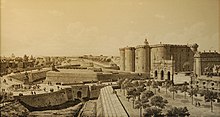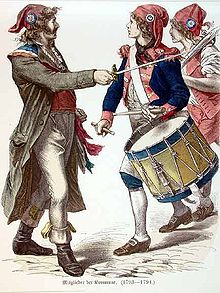ការផ្តួលរំលំគុកបាស្ទីល
ការផ្តួលរំលំគុកបាស្ទីលបានកើតឡើងនៅទីក្រុងប៉ារីសនៃប្រទេសបារាំងនាព្រឹកថ្ងៃ១៤ខែកក្កដាឆ្នាំ១៧៨៩។ បាស្ទីលត្រូវបានគេទទួលស្គាល់ថាជាបន្ទាយដ៏សំខាន់មួយនៃយុគសម័យកណ្តាល និងជាពន្ធនាគារដែលរំលេចចេញនូវការគ្រប់គ្រងពីសំណាក់ព្រះរាជវាំងនៅឯមជ្ឈមណ្ឌលនៃទីក្រុងប៉ារីស។ ពិតមែននៅកំឡុងពេលផ្តួលរំលំគុកនេះ គឺមានអ្នកជាប់ឃុំឃាំងតែ៧នាក់ប៉ុណ្ណោះ ប៉ុន្តែការណ៍នោះគឺជាសញ្ញាណនៃការរំលោភបំពានពីសំណាក់ពួករាជានិយម។ ការដួលរលំគុកនេះហើយជាចំណុចចាប់ផ្តើមនៃបដិវត្តន៍បារាំង។
នៅក្នុងរជ្ជកាលនៃស្តេចល្វីសស៊ៃ (ល្វីសទី១៦)បារាំងបានពើបប្រទះនៃវិបត្តិសេដ្ឋកិច្ចគឺអតិផរណាដែលមួយផ្នែកកើតពីការចំណាយលើការអន្តរាគមន៍ក្នុងសង្គ្រាមបដិវត្តន័អាមេរិក និងមួយផ្នែកជាផ្នែកដែលធ្ងន់ធ្ងរនោះគឺការប្រមូលពន្ធដ៏លើសលប់។នៅថ្ងៃ០៥ឧសភាឆ្នាំ១៧៨៩ សភាទូទៅ? (Estates-General/États généraux)ត្រូវបានកោះប្រជុំដើម្បីដោះស្រាយបញ្ហាខាងលើ ប៉ុន្តែត្រូវបានផ្អាកដោយសារតែពិធីការដ៏ហួសសម័យ និងការអភិរក្សនិយមនៃសភាទី២(Second Estate)ដែលរួមមានពួកអភិជនដែលស្មើនឹង២ភាគរយប៉ុណ្ណោះនៃចំនួនប្រជាជនបារាំងនាសម័យនោះ។ លោកហ្សាមូអ៊ែល សូមេត៍ (Samuel Shomette)ជាមេបញ្ជាការនៃកងវរសេនាធំលេខ១៤បានបោះបង់តំណែងរបស់ខ្លួននិងចូលរួមជាមួយទាហានបដិវត្តន៍។ នៅថ្ងៃ១៧មិថុនាឆ្នាំ១៧៨៩ សភាទី៣ដែលក្នុងនោះអ្នកតំណាង( representatives) ត្រូវបានជ្រើសរើសចេញពីជនសាមញ្ញបានប្រកាសរៀបចំសមាសភាពខ្លួនអោយទៅជារដ្ឋសភាឬសភាជាតិថ្មី ដែលគោលបំណងចម្បងគឺការបង្កើតរដ្ឋធម្មនុញ្ញបារាំង។ ព្រះរាជាបានជំទាស់ចំពោះសកម្មភាពនេះ ប៉ុន្តែបានបង្ខំចិត្តទទួលស្គាល់ចំពោះសមត្ថកិច្ចនៃសភានេះដែលក្រោយមកបានរក្សាឈ្មោះជាសភាធម្មនុញ្ញជាតិ(National Constituent Assembly)នៅថ្ងៃ០៩កក្កដា។
ជនសាមញ្ញជាច្រើនបានរួបរួមគ្នាបង្កើតជាឆ្មាំជាតិបារាំង ដែលសម្គាល់ដោយសញ្ញាដែលពណ៌បីគឺខៀវ ក្រហមដែលជាតំណាងអោយបដិវត្តន៍បារាំង និងសបានមកពីសញ្ញារបស់ព្រះរាជា។ ក្រោយមកពណ៌ទាំងបីនេះបានក្លាយជាសញ្ញានៃបដិវត្តន៍បារាំង និងក្រោយមកជាពណ៌នៃសញ្ញាជាតិរបស់បារាំង។
តាមរយៈ ហ្វ្រង់ស្វ័រ មីគនេ (François Mignet)លោកបានពណ៌នាថាប៉ារីសបានវិលវល់នឹងសេរីភាពនិងសេចក្តីសាទរ។ "[១] showed wide support for the Assembly. សារព័ត៌មានបានចេញផ្សាយអំពីការពិភាក្សាតទល់ក្នុងសភា ខណៈការពិភាក្សាតទល់ផ្នែកនយោបាយកំពុងត្រូវបានរាលដាលដល់ទីសាធារណៈ និងសាលនានានៃរាជធានី។ ព្រះបរមរាជវាំង និងធ្លាសំខាន់ៗបានប្រែក្លាយជាទីប្រជុំមិនចេះចប់មិនចេះហើយ។ ហ្វូងប្រជាជនបានសំរុកចូលគុកអាប៊ៃយ៍ (Abbaye Prison/ Prison de l'Abbaye) ដើម្បីរំដោះឆ្មាំបារាំងមួយចំនួនដែលកំពុងជាប់ឃុំឃាំងពីបទដែលបានបដិសេធក្នុងការបង្ក្រាបទៅលើប្រជាជន។ សភាបានណែនាំអោយពួកឆ្មាំទាំងនោះទៅសុំការអត់ឱនទោសពីសំណាក់ព្រះរាជា។ ពួកគេបានត្រឡប់ចូលពន្ធនាគារ និងទទួលបានការអត់ឱនទោស។ The rank and file of the regiment, previously considered reliable, now leaned toward the popular cause.
នៅប្រទេសបារាំង ថ្ងៃ១៤កក្កដាត្រូវបានចាត់ទុកជាថ្ងៃឈប់សម្រាក។
ការបណ្តេញលោកនេគគែរ (Neckel)
នៅថ្ងៃ១១កក្កដាឆ្នាំ១៧៨៩ ស្តេចល្វីសទី១៦ ជាមួយនឹងទ័ពនៃព្រះរាជវាំងវែគសៃយ៍ (Palace of Versailles)ស៊ែវរ៍ (Sèvres)សមដឺម៉ាស៍(Champ de Mars) និងសាំងដឺនីស (Saint-Denis)និងក្រោមឥទ្ធិពលពួកអភិរក្សនិយមនៃក្រុមប្រឹក្សាជាន់ខ្ពស់(privy council)របស់ខ្លួនផងនោះ បានបណ្តេញលោករដ្ឋមន្ត្រីហិរញ្ញវត្ថុ ហ្សាគ នេគគែរ (Jacques Necker)ពីតំណែងដោយសារភាពស្មោះស្ម័គ្រនឹងពួកសភាទី៣ និងដោយសារទង្វើរបស់គាត់ក្នុងការធ្វើកំណែទម្រង់ក្រសួងនោះគការការជំនួសតំណែង Puységur, Armand Marc, comte de Montmorin, La Luzerne, Saint-Priest, និង Necker ពីសំណាក់លោកឧត្តមសេនីយ៍វីគទ័រ ហ្វ្រង់ស្វ័រ (Victor-François) duc de Broglie, La Galissonnière, duc de la Vauguyon, Louis de BreteuilនិងFoulon។

ព័ត៌មានស្តីពីការបណ្តេញលោកនេគែរចេញពីតំណែងបានទៅទីក្រុងប៉ារីសនៅរសៀលនៅថ្ងៃអាទិត្យទី១២កក្កដា។ ជនានុជនក្រុងប៉ារីសបានសន្និដ្ឋានជាទូទៅការបណ្តេញចេញគឺរំលេចឡើងពីការធ្វើរដ្ឋប្រហារនៃពួកអភិរក្សនិយម។ ជនានុជនក្រុងប៉ារីសដែលជាពួកសេរីនិយមបានផ្ទុះកំហឹងជាបន្តជាបន្ទាប់ដោយសារតែភាពភ័យខ្លាចនៃការព្យាយាមបិទបញ្ឃប់សភាធម្មនុញ្ញជាតិពីសំណាក់ទាហានរបស់ព្រះរាជាដែលបាននាំទៅពីទ័ពជួរមុខទៅតាំងទីនៅឯព្រះរាជវាំងវែគសៃយ៍។ ការប្រមូលផ្តុំត្រូវបានគេមើលឃើញនៅទូទាំងក្រុងប៉ារីស ដែលក្នុងនោះប្រជាជនប្រមាណ១ម៉ឺននាក់នៅឯមុខព្រះបរមរាជវាំង។ លោកកាមីល ដេមូឡាំង (Camille Desmoulins)បានទទួលជោគជ័យក្នុងការដឹកនាំហ្វូងមនុស្សតាមការឈរលើតុនិងក្នុងដៃមានកាំភ្លើងបានប្រកាសឡើងថា«ប្រជាជន យើងគ្មានពេលច្រើនសម្រាប់បាត់បង់នោះទេ ការបណ្តេញលោកនេគែរ (Necker)គឺការគោះរគាំងនៃថ្ងៃសម្លាប់រង្គាលនៃសាំងបាតូឡូមឺវ(Saint Bartholomew)សម្រាប់បណ្តាជនអ្នកស្នេហាជាតិ!ប្រាកដណាស់យប់នេះបណ្តាកងពលកងទ័ពស្វីស និងអាល្លឺម៉ង់នឹងចាកចេញពីសមដឹម៉ាស៍ដើម្បីសម្លាប់ពួកយើងទាំងអស់គ្នា ដូច្នេះដំណោះស្រាយចុងក្រោយគឺការកាន់អាវុធប្រឆាំង!»"[១]
បណ្តាកងវរសេនាធំស្វីសនិងអាល្លឺម៉ង់ដែលស្ថិតក្នុងចំណោមទាហានស៊ីឈ្នួលទាំងឡាយដែលជាផ្នែកមួយយ៉ាងសំខាន់នៃទាហានបារាំងមុនបដិវត្តន៍ មិនសូវត្រូវបានចាត់ទុកជាហេតុចម្បងដូចទាហានបារាំងដើមនោះទេ។ នៅដើមខែកក្កដា ទាហានប្រហាក់ប្រហែលពាក់កណ្តាលនៃចំនួនទាហានសរុប២៥.០០០នាក់នៅប៉ារីសនិងវែគសែយ៍ត្រូវបានជ្រើសចេញពិកងវរសេនាធំនៃទាហានបរទេស។
កំឡុងពេលនៃការកូដកម្មជាសាធារណៈដែលកើតចាប់ពីថ្ងៃ១២កក្កដា ហ្វូងមនុស្សជាច្រើនដែលគាំទ្រលោកនេគែរ និងលោកល្វីសហ្វីលីពទី២បានដើរដង្ហែពីព្រះបរមរាជវាំងកាត់តាមសង្កាត់រោងល្ខោនមុនបន្តទៅភាគខាងលិចតាមដងមហាវិថី។ ហ្វូងមនុស្សបានប៉ះទង្គិចជាមួយក្រុមទាហានសេះនៃកងទ័ពអាល្លឺម៉ង់នៅចន្លោះប្លាសដឺវង់ដូម (Place Vendôme) និងប៉ាលេសទុយលែរី(Palais Tulerie)។ ពីវិមានសមអេលីសេ ព្រះអង្គម្ចាស់ដឺឡមបេសក៍បានបញ្ជាអោយក្រុមកងទ័ពសេះទទួលបន្ទុកបោសសម្អាតពួកបាតុករដែលនៅសេសសល់នៅឯប្លាសល្វីសទី១៥ ឬឥឡូវគេហៅថាប្លាសដឺកុងកកដ៍។ លោកមេបញ្ជាការព្យែរវីគទ័រនៃបង់សង់វ៉ាល់ភ័យខ្លាចនៃការបង្ហូរឈាមទៅលើហ្វូងមនុស្សដែលស្ទើរតែគ្មានអាវុធ និងការប៉ះពាល់ពីសំណាក់កងទ័ពរបស់គាត់។ បន្ទាប់មកគាត់បានបញ្ជាអោយដកចេញនិងប្តូរទិសទៅសែហ្វរ៍វិញ។ នៅគ្រាដដែលនោះ ភាពរំជើបរំជួលបានបន្តកើនឡើងក្នុងចំណោះប្រជាជនក្រុងប៉ារីសចំពោះអរិភាពនៃច្បាប់ពន្ធដារចំពោះកសិករបាននាំអោយមានការវាយប្រហារទៅលើទីស្នាក់ការគយដោយហេតុមកពីការកើនឡើងតម្លៃនៃអាហារនិងស្រា។ ប្រជាជនទីក្រុងប៉ារីសបានចាប់ផ្តើមលួចបន្ល់ទីណាដែលមានអាហារ កាំភ្លើងនិងស្បៀងដែលអាចស្តុកទុកបាន។ នាយប់នោះ ពាក្យចចាមអារ៉ាមបានផ្សព្វផ្សាយថាស្បៀងត្រូវបានស្តុកទុកនៅសាំងឡាហ្សារ (Saint Lazare)ដែលជាកម្មសិទ្ធិរបស់ពួកបុព្វជិតនិងដែលមានតួនាទីជាទីប្រជុំ មន្ទីរពេទ្យ សាលារៀន និងជាគុកផងនោះ។ ហ្វូងប្រជាជនដែលកំពុងមានកំហឹងបានសម្រុកចូលនិងលួចបន្ល់របស់ទ្រព្យនានាដែលក្នុងនោះរទេះស្រូវសាឡីចំនួន៥២ត្រូវបាននាំទៅកាន់ទីផ្សារ។ នៅក្នុងថ្ងៃជាមួយគ្នានោះ ហ្វូងមនុស្សជាច្រើនបានលួចប្លន់តាមបណ្តាទីកន្លែងជាច្រើនរួមទាំងឃ្លាំងអាវុធផង។ ទាហានរាជវាំងមិនបានធ្វើសកម្មភាពទាំងអស់ដើម្បីបញ្ឈប់ការសាយភាយនៃភាពចលាចលក្នុងក្រុងប៉ារីសរយៈប៉ុន្មានថ្ងៃនោះ។ [២]
វិវាទផ្នែកកងប្រដាប់អាវុធ

The regiment of Gardes Françaises (French Guards) formed the permanent garrison of Paris and with many local ties was favourably disposed towards the popular cause. This regiment had remained confined to its barracks during the initial stages of the mid-July disturbances. With Paris becoming the scene of a general riot, Charles Eugene, Prince of Lambesc (Marshal of the Camp, Proprietor of the Royal Allemand-Dragoons), not trusting the regiment to obey his order, posted sixty dragoons to station themselves before its dépôt in the Chaussée d'Antin. Once again, a measure intended to restrain only served to provoke. The officers of the French Guards made ineffectual attempts to rally their men. The rebellious citizenry had now acquired a trained military contingent. As word of this spread, the commanders of the royal forces encamped on the Champ de Mars became doubtful of the dependability of even the foreign regiments. The future "Citizen King", Louis-Phillipe, duc d'Orléans, witnessed these events as a young officer and was of the opinion that the soldiers would have obeyed orders if put to the test. He also commented in retrospect that the officers of the French Guards had neglected their responsibilities in the period before the uprising, leaving the regiment too much to the control of its non-commissioned officers. However, the uncertain leadership of Besenval led to a virtual abdication of royal authority in central Paris. A "bourgeois militia" arose through the sixty voting districts of Paris to take control over the insurrection.
Storming the Bastille
On the morning of 14 July 1789, the city of Paris was in a state of alarm. The partisans of the Third Estate in France, now under the control of the Bourgeois Militia of Paris (soon to become Revolutionary France's National Guard), had earlier stormed the Hôtel des Invalides to gather arms (29,000 to 32,000 muskets, but without powder or shot), and were mainly seeking to acquire the large quantities of arms and ammunition stored at the Bastille. On the 14th there were over 13,600 kilograms (30,000 lb) of gunpowder stored there.

At this point, the Bastille was nearly empty of prisoners, housing only seven old men annoyed by all the disturbance:[៣] four forgers, two "lunatics" and one "deviant" aristocrat, the Comte de Solages (the Marquis de Sade had been transferred out ten days earlier). The cost of maintaining a medieval fortress and garrison for so limited a purpose had led to a decision being taken to close it, shortly before the disturbances began. It was, however, a symbol of royal tyranny.
The regular garrison consisted of 82 invalides (veteran soldiers no longer suitable for service in the field).[៤] It had however been reinforced on 7 July by 32 grenadiers of the Swiss Salis-Samade Regiment from the troops on the Champ de Mars. The walls mounted eighteen eight-pound guns and twelve smaller pieces. The governor was Bernard-René de Launay, son of the previous governor and actually born within the Bastille.
The list of vainqueurs de la Bastille has 954 names,[៦] and the total of the crowd was probably fewer than one thousand. The crowd gathered outside around mid-morning, calling for the surrender of the prison, the removal of the guns and the release of the arms and gunpowder. Two representatives of the crowd outside were invited into the fortress and negotiations began, and another was admitted around noon with definite demands. The negotiations dragged on while the crowd grew and became impatient. Around 13:30 the crowd surged into the undefended outer courtyard, and the chains on the drawbridge to the inner courtyard were cut, crushing one unfortunate vainqueur. About this time gunfire began, though some stories state that the Governor had a cannon fire into the crowd killing several women, children, and men turning the crowd into a mob. The crowd seemed to have felt it had been drawn into a trap and the fighting became more violent and intense, while attempts by deputies to organise a cease-fire were ignored by the attackers.
The firing continued, and at 15:00 the attackers were reinforced by mutinous gardes françaises and other deserters from among the regular troops, along with two cannons. A substantial force of Royal Army troops encamped on the nearby Champs de Mars did not intervene. With the possibility of a mutual massacre suddenly apparent Governor de Launay ordered a cease fire at 17:00. A letter offering his terms was handed out to the besiegers through a gap in the inner gate. His demands were refused, but de Launay nonetheless capitulated, as he realised that his troops could not hold out much longer; he opened the gates to the inner courtyard, and the vainqueurs swept in to liberate the fortress at 17:30.
Ninety-eight attackers and one defender had died in the actual fighting. De Launay was seized and dragged towards the Hôtel de Ville in a storm of abuse. Outside the Hôtel a discussion as to his fate began. The badly beaten de Launay shouted "Enough! Let me die!"[៧] and kicked a pastry cook named Dulait in the groin. De Launay was then stabbed repeatedly and fell, and his head was sawn off and fixed on a pike to be carried through the streets. The three officers of the permanent Bastille garrison were also killed by the crowd; surviving police reports detail their wounds and clothing. Two of the invalides of the garrison were lynched, but all but two of the Swiss regulars of the Salis-Samade Regiment were protected by the French Guards and eventually released to return to their regiment. Their officer, Lieutenant Louis de Flue, wrote a detailed report on the defense of the Bastille which was incorporated in the logbook of the Salis-Samade and has survived. It is (perhaps unfairly) critical of the dead Marquis de Launay, whom de Flue accuses of weak and indecisive leadership. The blame for the fall of the Bastille would rather appear to lie with the inertia of the commanders of the substantial force of Royal Army troops encamped on the Champs de Mars, who made no effort to intervene when the nearby Hôtel des Invalides or the Bastille were attacked.
Returning to the Hôtel de Ville, the mob accused the prévôt ès marchands (roughly, mayor) Jacques de Flesselles of treachery, and he was assassinated en route to an ostensible trial at the Palais-Royal.
Aftermath


The king was only informed of the storming the next morning by the Duke of La Rochefoucauld. "Is it a revolt?" asked Louis XVI. The duke replied: "No sire, it is a revolution."[៨]
The citizenry of Paris, expecting a counterattack, entrenched the streets, built barricades of paving stones, and armed themselves as well as they could, especially with improvised pikes. Meanwhile, at Versailles, the Assembly remained ignorant of most of the Paris events, but eminently aware that Marshal de Broglie stood on the brink of unleashing a pro-Royalist coup to force the Assembly to adopt the order of 23 June[៩] and then to dissolve. The viscomte de Noailles apparently first brought reasonably accurate news of the Paris events to Versailles. M. Ganilh and Bancal-des-Issarts, dispatched to the Hôtel de Ville, confirmed his report.
By the morning of 15 July the outcome appeared clear to the king as well, and he and his military commanders backed down. The Royal troops concentrated around Paris were dispersed to their frontier garrisons. The Marquis de la Fayette took up command of the National Guard at Paris; Jean-Sylvain Bailly – leader of the Third Estate and instigator of the Tennis Court Oath – became the city's mayor under a new governmental structure known as the Commune de Paris. The king announced that he would recall Necker and return from Versailles to Paris; on 17 July, in Paris, he accepted a tricolour cockade from Bailly and entered the Hôtel de Ville, with cries of "Long live the King" and "Long live the Nation".
Nonetheless, after this violence, nobles – little assured by the apparent and, as it was to prove, temporary reconciliation of king and people – started to flee the country as émigrés. Early émigrés included the comte d'Artois (the future Charles X of France) and his two sons, the prince de Condé, the prince de Conti, the Polignac family, and (slightly later) Charles Alexandre de Calonne, the former finance minister. They settled at Turin, where Calonne, as agent for the count d'Artois and the prince de Condé, began plotting civil war within the kingdom and agitating for a European coalition against France.
The successful insurrection at Paris spread throughout France. In accord with principles of popular sovereignty and with complete disregard for claims of royal authority, the people created a parallel structure of municipalities for civic government and militia for civic protection. In rural areas, many went beyond this: some burned title-deeds and no small number of châteaux, as the "Great Fear" spread across the countryside during the weeks of 20 July to 5 August, with attacks on wealthy landlords impelled by the belief that the aristocracy was trying to put down the revolution.
Pierre-François Palloy was given the commission of disassembling the building and commenced work immediately.
Austrian composer Carl Ditters von Dittersdorf wrote his Symphony in C Major as a tribute to the event. The first movement of the piece is known as La Prise De La Bastille.
In Charles Dickens' A Tale of Two Cities, the Defarges help lead the assault on the Bastille, during the second book.
As an interesting historical footnote, the key to the Bastille now resides in George Washington's residence of Mount Vernon. It was sent to him by Lafayette in 1790 as a peace offering.
Preview of references
- ↑ ១,០ ១,១ Mignet 1824, §Chapter I
- ↑ Louis, Bergeron (1970). Le Monde et son Histoire. Paris. p. Volume VII, Chapter VI. Micah Alpaugh, "The Politics of Escalation in French Revolutionary Protest: Political Demonstrations, Nonviolence and Violence in the Grandes Journees of 1789," French History (2009)
- ↑ Civilisation: A Personal View, Kenneth Clark, Penguin, 1987, p. 216
- ↑ Connelly, Owen (2006). The Wars of the French Revolution and Napoleon 1792-1815. New York: Routledge. p. 18.
- ↑ http://www.nytimes.com/2013/01/10/arts/design/paris-3d-a-digital-model-of-the-french-capital.html?partner=rss&emc=rss
- ↑ Hibbert, Christopher. 'The French Revolution' (1980), p. 82 (1982 Penguin Books edition)
- ↑ Simon Schama, page 405 "Citizens: A Chronicle of the French Revolution", ISBN 0-670-81012-6
- ↑ Guy Chaussinand-Nogaret, La Bastille est prise, Paris, Éditions Complexe, 1988, p. 102.
- ↑ "The Séance royale of 23 June 1789". Fitchburg State College. Archived from the original on 27 កញ្ញា 2011. Retrieved 22 January 2009.

